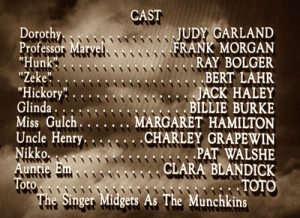The Wizard of Oz never fails to sweep me up in its fantastical technicolor world. To this day, I sympathize with Dorothy during her heartbreaking, stir-crazy lament in “Somewhere Over the Rainbow,” laugh at the Cowardly Lion’s same corny jokes and demeanor, and marvel at the idiosyncratic and act-deco magic of the Emerald City. Like books, films have always fascinated me as a form of escapism, and The Wizard of Oz is no exception–for two hours, I can imagine myself as a young, precocious girl from Kansas and explore the world of Oz. Imagine my surprise and disappointment, then, when the film ended and the credits rolled without any mention of the fantastical characters I had just encountered. Instead of seeing the Wizard, the Scarecrow, the Tin Man, the Cowardly Lion, and the Wicked Witch of the West, the list credits the actors who played their real-life, sepia counterparts of Professor Marvel, Hunk, Hickory, Zeke, and Miss Gulch. Avid fans of the film remember that Dorothy returns back to Kansas by waking up from a dream and recognizing the characters she met in Oz as her friends and family. Both the plot and the production design of the movie reaffirm the idea that Oz is nonexistent, a figment of Dorothy’s fever dreams about running away from her home. Yet, like any form of escapist media, I, as well as many other passionate viewers, get easily swept up in the supposedly fake characters and events of Oz.
Whose depiction of reality matters more to a piece of media–the consumer’s, or the creator’s? Since Baum does not emphasize the dreamlike qualities of Oz at the end of the original novel, what is the point of delegitimizing the reality and tangibility of Oz?
